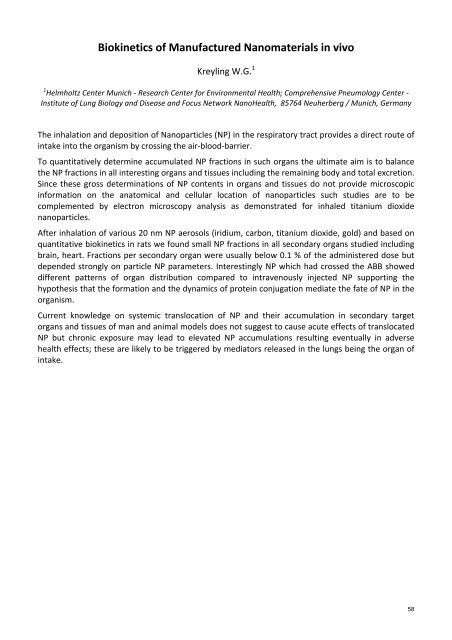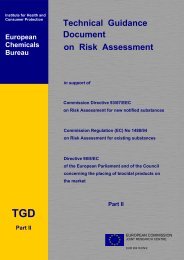Challenges of Regulation and Risk Assessment of Nanomaterials
Challenges of Regulation and Risk Assessment of Nanomaterials
Challenges of Regulation and Risk Assessment of Nanomaterials
You also want an ePaper? Increase the reach of your titles
YUMPU automatically turns print PDFs into web optimized ePapers that Google loves.
Biokinetics <strong>of</strong> Manufactured <strong>Nanomaterials</strong> in vivo<br />
Kreyling W.G. 1<br />
1Helmholtz Center Munich - Research Center for Environmental Health; Comprehensive Pneumology Center -<br />
Institute <strong>of</strong> Lung Biology <strong>and</strong> Disease <strong>and</strong> Focus Network NanoHealth, 85764 Neuherberg / Munich, Germany<br />
The inhalation <strong>and</strong> deposition <strong>of</strong> Nanoparticles (NP) in the respiratory tract provides a direct route <strong>of</strong><br />
intake into the organism by crossing the air-blood-barrier.<br />
To quantitatively determine accumulated NP fractions in such organs the ultimate aim is to balance<br />
the NP fractions in all interesting organs <strong>and</strong> tissues including the remaining body <strong>and</strong> total excretion.<br />
Since these gross determinations <strong>of</strong> NP contents in organs <strong>and</strong> tissues do not provide microscopic<br />
information on the anatomical <strong>and</strong> cellular location <strong>of</strong> nanoparticles such studies are to be<br />
complemented by electron microscopy analysis as demonstrated for inhaled titanium dioxide<br />
nanoparticles.<br />
After inhalation <strong>of</strong> various 20 nm NP aerosols (iridium, carbon, titanium dioxide, gold) <strong>and</strong> based on<br />
quantitative biokinetics in rats we found small NP fractions in all secondary organs studied including<br />
brain, heart. Fractions per secondary organ were usually below 0.1 % <strong>of</strong> the administered dose but<br />
depended strongly on particle NP parameters. Interestingly NP which had crossed the ABB showed<br />
different patterns <strong>of</strong> organ distribution compared to intravenously injected NP supporting the<br />
hypothesis that the formation <strong>and</strong> the dynamics <strong>of</strong> protein conjugation mediate the fate <strong>of</strong> NP in the<br />
organism.<br />
Current knowledge on systemic translocation <strong>of</strong> NP <strong>and</strong> their accumulation in secondary target<br />
organs <strong>and</strong> tissues <strong>of</strong> man <strong>and</strong> animal models does not suggest to cause acute effects <strong>of</strong> translocated<br />
NP but chronic exposure may lead to elevated NP accumulations resulting eventually in adverse<br />
health effects; these are likely to be triggered by mediators released in the lungs being the organ <strong>of</strong><br />
intake.<br />
58








